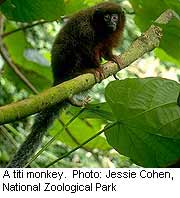
THURSDAY, July 14 (HealthDay News) — A novel version of a virus responsible for many well-known illnesses in humans and animals has managed to jump from one species and spark infection in another, according to researchers.
This “jumping” virus is from the adenovirus family, responsible for the common cold, croup, pneumonia and many other illnesses in humans. Until now — unlike other types of viruses — these particular germs have not been thought capable of cross-species transmission.
The finding stems from a high-tech investigation of a 2009 California laboratory outbreak that ravaged a population of New World titi research monkeys. The never-before-seen virus that caused a high rate of death among the primates is the same virus that sickened a lab researcher who had come into direct contact with the infected animals, the scientists reported.
And once the virus migrated to a human host, it continued its travels, infecting a member of the researcher’s family, who had no history of exposure to any infected animal.
“Adenoviruses have been thought to be species-specific,” said study lead author Dr. Charles Chiu, an assistant professor of laboratory medicine and infectious diseases at the University of California, San Francisco. “That’s been the traditional thinking. But we found a novel adenovirus that is unlike any other virus that’s been previously described. And it appears to be able to cross species,” he added.
“But I definitely don’t want to alarm people,” said Chiu, who also serves as director of the UCSF Viral Diagnostics and Discovery Center, which led the current investigation. “Yes, this was a very deadly virus among the monkeys — perhaps the deadliest adenovirus ever seen. But this happened two years ago now, and we haven’t seen any evidence at all that this virus or any virus of its kind has continued to spread through the human population.”
Chiu and his colleagues reported the case in the July 14 issue of PLoS Pathogens.
Besides respiratory illnesses, adenoviruses can cause conjunctivitis, hepatitis, bladder and intestinal infections in humans, as well as serious — even deadly — infections in animals.
The outbreak at the heart of what researchers once viewed as a viral mystery took place at the California National Primate Research Center at the University of California, Davis, among a colony of 65 titi monkeys.
In 2009, over one-third of the primates developed upper-respiratory symptoms, which soon turned into severe pneumonia and hepatitis. Despite intensive medical treatment, more than 80 percent of the sick monkeys died.
Researchers named the virus responsible for the outbreak “titi monkey adenovirus” (TMAdV).
A researcher who was in close contact with the monkeys, who also developed a severe respiratory illness, remained ill for about a month with symptoms that included fever, cough and chills. In addition, two family members developed a similar illness, despite having had no exposure to the laboratory setting. All three made a complete recovery.
But was the same virus to blame for the severe illnesses in both the animals and humans? State-of-the-art blood and antibody analyses suggest that in two of the cases, it was: the researcher and one family member tested positive for the same adenovirus that infected the hapless monkeys.
The study authors noted that the virus might have originated with the monkeys and spread to humans; or it could have taken the opposite tack.
Either way, the research team said that because of the unusually high fatality rate among the New World primates at the research center, it is probable that neither humans nor the titi monkeys served as the original viral “host.” If such suspicions hold true, then the identification of a so-called “patient zero” remains an unsolved riddle.
Chiu did find antibodies to the novel adenovirus in one healthy rhesus (Old World) monkey, leading him to suggest that the virus might have spread from Old World monkeys to the New World colony that had no antibodies against it.
The importance of getting to the bottom of such lingering questions led Chiu to suggest that the investigation has so far only “touched the tip of the iceberg.”
“Nature finds a way to introduce a new virus every couple of years,” he said. “And this means we have to be alert to viruses and the risk for spreading into the human population.”
This is important, Chiu said, “because most of the viruses that we know cross over from animals to human all the time don’t stick. They don’t go anywhere. So if we find that they can cross, and then acquire the ability to move from human to human, that’s a cause for worry. Because those two factors are what raise the risk for a pandemic. And this case suggests that perhaps we might want to track these animal viruses a bit more before they have the chance to cross over into the human population.”
For his part, Dr. Pascal James Imperato, dean of the School of Public Health at the State University of New York Downstate Medical Center in New York City, emphasized that while questions about the case endure, the public should not be unduly alarmed.
“Clearly, this virus was not indigenous to the monkeys who were affected,” he noted. “If these monkeys were the normal host for this species they would have accommodated to it, and they wouldn’t have died off at this rate. So it was introduced to them. And the question is, from which species was it introduced and how?” Imperato said.
“But on the positive side, I would say that the risk here would appear to be low,” he added. “And the reason we can say that is that there were no other reported secondary cases to the primary human case — at least not in a serious form of the illness — as far as one can document this. And these two individuals who were infected recovered, which is also positive. So I think the public is not at risk here.”
More information
For more on adenoviruses, visit the U.S. Centers for Disease Control and Prevention.

